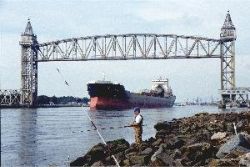|
|

The railroad bridge stays in this lifted position for most of the day. It only lowers for a few trains a day. This photo is at or near slack water. (Photo courtesy of US Army Corps of Engineers )
|

How To Go Through Cape Cod Canal
by Peter J. Wihtol
Our thanks to our friends at the US Army Corps of Engineers, Cape Cod Canal for additional tips and updates.
Cape Cod Canal: 200 Yards Wide, 7.5 Nm Long, 32 Feet Deep, 5-6 Knot Max. Current
Your Two Major Boating Problems
-
Making minimal-to-no headway against the maximum current in a displacement hull boat. In order to avoid this problem you have to know what the current through the canal will be doing the day you will be coming through here. What is unusual is that the tidal current here, for the Canal is the result of two very different tidal schedules: one inside Cape Cod and the other on the Buzzards Bay side. One cannot say that the tide and the current changes so many hours after it does in Boston or at the mouth of Narragansett Bay. You must look up this tidal/current schedule in The Eldridge Tide and Pilot Book or in another New England area tidal publication. You can also view the Canal's tidal tables on their website at www.nae.usace.army.mil/recreati/ccc/navigation/navigation.htm. Other navigational tips, history and notices can be seen there. The US Army Corps of Engineers publishes and distributes free of charge tide tables for the Canal. People can stop by their office, Visitor Center, recreation areas, local fishing and boating stores or marinas to pick up a copy.
-
Passing through the canal and then meeting impossible weather and seas at the other end. Refuge can be had at the northeastern (Sandwich) end of the Canal in the East Boat Basin. Here there are slips only, no anchoring, no moorings. Why? The area is so small that slips are more space-effective. The East Boat Basin is easy to find, it's just east of the 305' smoke stack on the power plant. If you need shelter at the southwestern end of the Canal, in the West Mooring Basin there is no anchoring or mooring permitted here either. It is only for the very large vessels. At this end of the Canal your best overall choice to go is Onset.
Basic Rules For Going Through The Canal
- No stopping or anchoring in the canal.
- No fishing from your boat.
- All boats must motor through. Sails can be up.
- Vessels going with the current have the right of way.
- Vessels under 65 feet long will give way to larger vessels.
- Maximum speed: 10 mph, but you must take no longer than 2.5 hours to travel through the Canal.
- Minimize the wake when passing the moorings, boat basin facilities, and anchored maintenance work boats.
The Railroad Bridge is at the southwestern end and is lowered two or three times a day for an approaching train. The clearance, when it is lowered, is only 7 feet, so wait at the big, white, "STOP HERE" signs until the bridge is in the open (raised) position. In the vicinity of the lowered bridge there is usually a US Army Corps of Engineers patrol boat with a black hull, white superstructure, and a flashing blue strobe light to remind you not to pass.
Should you have an emergency in the canal like lost steering or power, ran out of fuel, etc. radio the Marine Traffic Control on Channel 13 and they will send a patrol boat to help you (no charge). If you are near the east end, near the USCG Station, then radio the USCG on Channel 16. They would likely be able to respond faster.Which to call is up to you. They have dual coverage.
The Biggest Pet Peeves Of The Army Corps
- Boats not just passing through, but buzzing around and reversing direction in the Canal. This is not a slalom course.
- Sail boats not using motor power.
- People fishing from a boat while in the Canal.
Best Single Channel To Monitor: VHF 13
Channel For Emergencies: VHF 16
For Information Call:
-
US Army Corps of Engineers: 508-759-4431 VHF 13
-
Canal Office, Buzzards Bay Marine Traffic Control is X 500
-
Marine Traffic Contollers (Direct line) 978-318-8500
-
US Coast Guard, Canal Station: 508-888-0020 VHF 16
-
Hot Line for that day's tide and weather information 508-759-5991
-
Sandwich Harbormaster / Sandwich Marina: 508-833-0808 VHF 9
-
Onset Harbormaster: 508-295-8160 VHF 9
|


